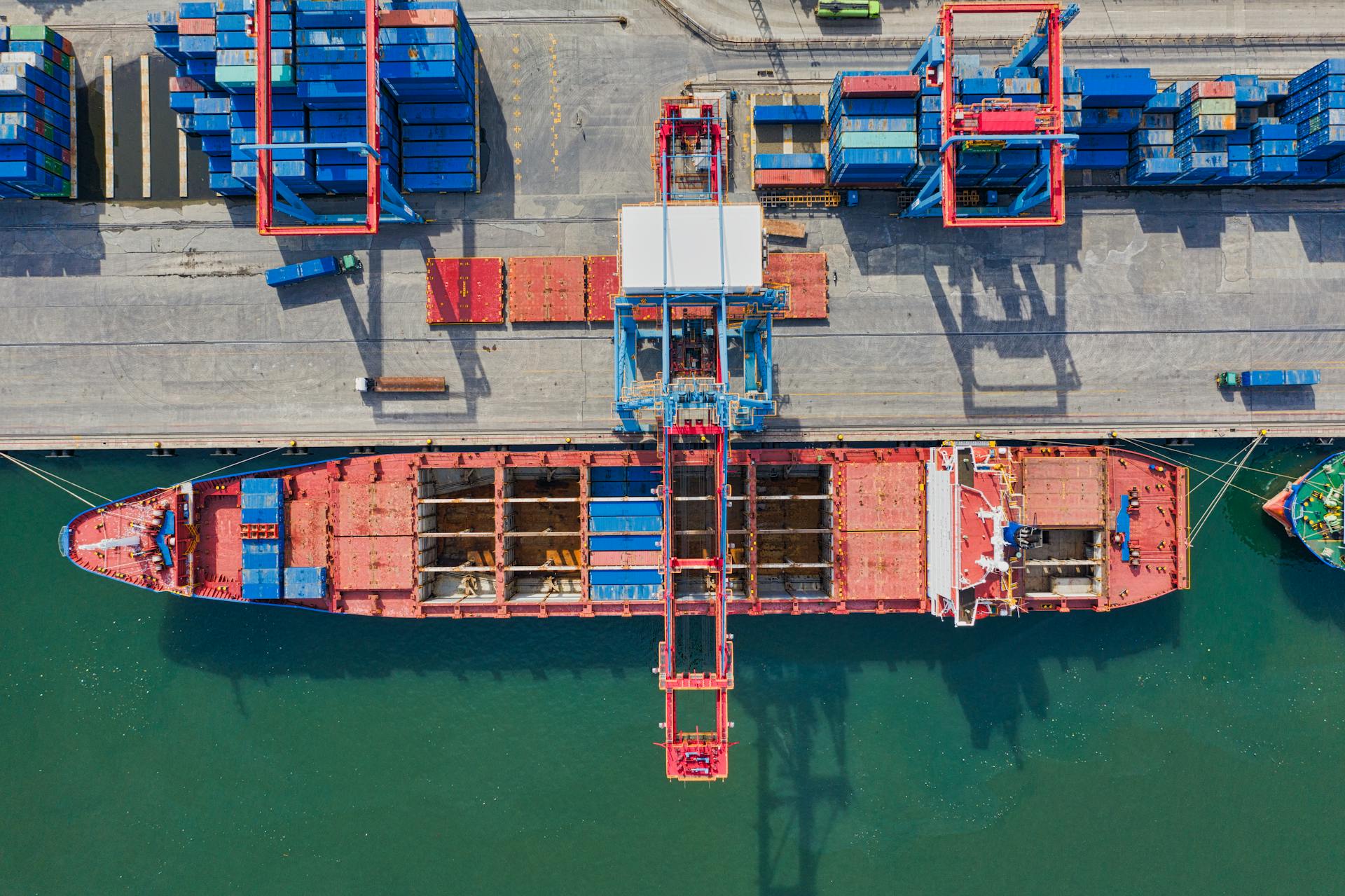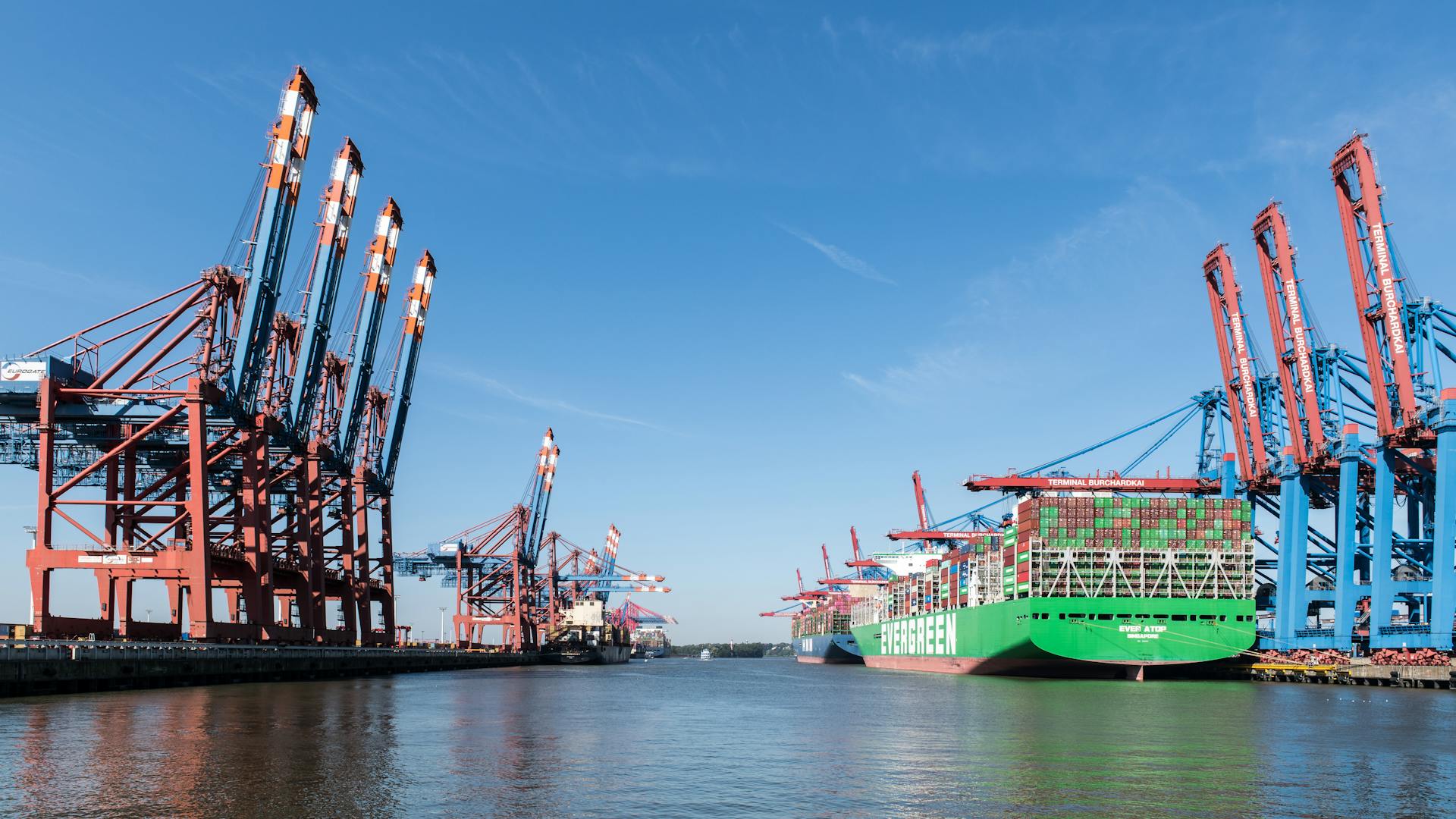
To navigate the customs clearance process in India, you'll need to submit a Bill of Entry, which must be accompanied by a commercial invoice and a packing list. This paperwork is crucial for clearing goods through customs.
The Bill of Entry must be filed electronically through the Indian Customs Electronic Data Interchange (EDI) system, which is mandatory for all importers. This system streamlines the process and reduces paperwork.
You'll need to pay a customs duty and other applicable charges, which vary depending on the type and value of the goods being imported. The rates are specified in the Customs Tariff Act of 1975.
Make sure to have all necessary documents in order, including a valid import license, to avoid any delays or penalties.
What is Customs Clearance in India?
Customs clearance in India is a crucial process that ensures compliance with customs regulations. It involves submitting required documents, paying customs clearance charges, duties, and ensuring compliance with regulations, allowing the shipment to legally enter or leave the country.
On a similar theme: Export Management and Compliance Program
The Central Board of Indirect Taxes and Customs (CBIC) oversees customs operations in India, formulating policies and enforcing customs regulations. Customs duties in India include basic customs duty, additional duties, and goods and services tax (GST), which importers and exporters must understand to calculate costs accurately.
The customs clearance process in India includes the classification of goods, valuation, and inspection. Importers must provide proper documentation, such as invoices, packing lists, and certificates of origin, to ensure smooth customs clearance.
Suggestion: Canada Import Duties from Us
Meaning
Customs clearance in India is the process of getting goods approved by customs authorities for import or export. This involves submitting required documents and paying customs clearance charges.
The process includes classification of goods, valuation, and inspection. Proper documentation, such as invoices, packing lists, and certificates of origin, must be provided.
Customs clearance is essential for international trade in India, ensuring that all legal and regulatory requirements are met. This streamlines the movement of goods across borders.
Tools like a CBM calculator can help ensure accurate shipment details, aiding in seamless documentation and avoiding discrepancies.
Here's a breakdown of the key terms and their requirements:
Overview of India

India has a complex customs clearance process, which is overseen by the Central Board of Indirect Taxes and Customs (CBIC). This board formulates policies, enforces customs regulations, and collects customs duties.
Customs duties in India include basic customs duty, additional duties, and goods and services tax (GST). Importers and exporters need to understand these duties to calculate costs accurately.
The Directorate General of Foreign Trade (DGFT) is responsible for implementing the government's foreign trade policy. This policy plays a crucial role in shaping India's customs clearance process.
Here are some key regulatory authorities in India that impact customs clearance:
- The Bureau of Indian Standards (BIS) is responsible for standardisation, marking, and quality certification of certain goods.
- The Wireless Planning Commission (WPC) regulates frequency spectrum management and requires approval for all wireless equipment.
- The Food Safety and Standards Authority of India (FSSAI) regulates food-related products.
- Plant Quarantine (PQ) regulates imports of plant and agriculture-related products.
- The Central Drugs Standard Control Organization (CDSCO) regulates pharmaceuticals and bulk drugs.
- Animal Quarantine (AQ) regulates imports of animals and animal-related products.
- Extended Producer's Responsibility (EPR) regulates electrical and electronic equipment, as well as plastic packaging.
Required Documents
To ensure smooth customs clearance in India, you'll need to gather the right documents. The list of required documents varies depending on the type of shipment, but here are some essentials:
The Bill of Entry is a crucial document that provides information about the imported goods, their value, and compliance with regulations.
On a similar theme: Customs Clearance Documents
The Commercial Invoice is another essential document that details the exported goods, their value, and compliance with customs regulations.
A Packing List is required to provide details about the packaged goods, including their weight, quantity, and description.
The Import License is required for certain goods, such as those subject to export control or restricted items.
The GSTIN (tax ID) is required for all shipments, and can be obtained from the Government of India.
You can submit the required documents to the customs authorities electronically or physically, depending on the designated port or airport.
Here is a summary of the required documents:
Accurate and complete documentation is crucial to avoid delays, penalties, or even the seizure of goods. Ensure that your commercial invoice, packing list, and bill of lading are in perfect order.
Import Procedures in India
To initiate the import process in India, you'll need to submit an Import General Manifest (IGM) or file a Bill of Entry through the Indian Customs Electronic Data Interchange System (ICES). This document provides detailed information about the goods being imported.
The next step involves classification and valuation of goods according to the Harmonized System of Nomenclature (HSN) codes. Customs authorities assess duties and taxes based on this classification.
Here's a breakdown of the required documents for imports: DocumentDescriptionCommercial invoiceProvides detailed information about the goods being importedPacking listLists the contents of the shipmentLicenses and certificates of originVerify the authenticity of the goods
These documents must be in order to avoid delays in the customs clearance process.
If this caught your attention, see: Carrier Received Documents Required for Customs Clearance
Packing List
A packing list is essential for importers in India to keep track of their cargo. It's a detailed document that itemises every piece of cargo, ensuring customs officials can verify the contents and account for everything.
The packing list contains information about the goods being imported, making it a crucial document for importers. It helps prevent scenarios where you might forget what you packed, which can lead to unnecessary delays.
In India, a packing list is required for shipments, and it's usually prepared along with other import documents. This list helps customs officials verify the contents of the shipment and ensure compliance with regulations.
You might like: Packing List for Export
To prepare a packing list, importers need to gather detailed information about the goods being imported, including their description, quantity, and weight. This information is essential for customs clearance and other regulatory purposes.
A well-prepared packing list can save importers a lot of time and hassle, especially during customs clearance. It's a simple but crucial step in the import process that's often overlooked.
You might enjoy: Us Export Control List Countries
Import Procedures in India
The customs clearance process in India is a crucial step in importing goods into the country. This process begins with the submission of an Import General Manifest (IGM) or Export General Manifest (EGM), detailing the cargo information.
To initiate the customs clearance process, importers must file a Bill of Entry through the Indian Customs Electronic Data Interchange System (ICES). This document provides detailed information about the imported goods, their value, and compliance with regulations.
Importers must also ensure that all required documents, such as invoices, packing lists, licenses, and certificates of origin, are in order. Customs authorities assess duties and taxes based on the classification of goods according to the Harmonized System of Nomenclature (HSN) codes.
Goods are then subject to customs inspection, which may include physical examination to verify the contents against the declared information. If everything complies with regulations, customs authorities will clear the goods, and a clearance certificate is issued.
The payment of any assessed duties and taxes is required before customs release can be obtained. Once cleared, goods can be transported to their final destination.
Here is a list of documents required for import customs clearance in India:
- Bill of Entry
- Commercial Invoice
- Packing List
- Import License (if applicable)
These documents provide essential information about the imported goods, their value, and compliance with regulations. By ensuring that all required documents are in order, importers can facilitate a smooth and efficient customs clearance process.
Curious to learn more? Check out: Documents Required for Import Customs Clearance in Usa
Assessment and Payment of Duties and Taxes
Customs authorities assess the customs duties and taxes applicable to the imported goods, including calculating the basic customs duty, additional duties, and GST based on the declared value of the goods.
Accuracy is critical when it comes to the commercial invoice, as it's the backbone of your customs clearance process and a detailed record of your transaction.
Importers are required to make the necessary payment of customs duties and taxes based on the assessed value, with various payment methods such as online transfers or demand drafts available for completing the payment process.
Self-assessment is crucial for navigating the customs clearance process, as knowing the details of Basic Customs Duty, Social Welfare Surcharge, and IGST can prevent unexpected costs and delays.
Exporters must pay any export duties or charges before obtaining the Let Export Order, with export duties levied on specific goods or in certain circumstances.
The payment of customs duties and taxes is a critical step in the customs clearance process, and importers must ensure they pay what's due to clear their goods.
You might enjoy: How to Pay Import Tax
Charges and Fees
Charges and Fees are a crucial aspect of customs clearance in India. Customs duty is a tax imposed on imported goods, varying based on the product type, value, and origin. It is calculated according to the Harmonized System of Nomenclature (HSN) codes.
Customs clearance charges and fees cover various services and regulatory requirements, including handling and processing fees, inspection and examination fees, brokerage fees, storage fees, and port charges. In addition to the import duties, India charges a 1% customs handling fee on all imports.
Here are the primary taxes involved in customs duty calculation: Basic Customs Duty (BCD), Social Welfare Surcharge, and Integrated Goods and Services Tax (IGST). BCD can be levied in two ways: a specific rate based on the unit of the item or an ad-valorem rate based on the assessable value of the item.
Additional costs in the customs clearance process include Agent Charges, Demurrage Fees, Penalty Fees, Re-export Fees, and Amendment Fees.
Curious to learn more? Check out: Customs Handling of Import & Export Freight
Charges & Fees
Customs clearance charges and fees can be overwhelming, but understanding the key components can help you navigate the process. Customs duty is a tax imposed on imported goods, varying based on the product type, value, and origin.

There are several types of customs duty, including Basic Customs Duty (BCD), which is the standard duty applied to imported goods. The peak customs duty in India currently stands at around 10%, which means that the highest essential duty imposed on the most significant number of imported goods is 10%.
In addition to customs duty, you'll also need to consider Goods and Services Tax (GST), which is applied to the import of goods. GST rates differ depending on the product category.
Handling and processing fees cover the administrative costs associated with the customs clearance process, including documentation, submission, and processing. These fees are typically charged by customs brokers or agents.
Here's a breakdown of the typical customs clearance charges and fees:
- Customs duty: varies based on product type, value, and origin
- GST: varies based on product category
- Handling and processing fees: charged by customs brokers or agents
- Inspection and examination fees: charged when goods are subject to physical inspection
- Brokerage fees: paid to customs brokers who assist with the clearance process
- Storage fees: incurred if goods are held in a customs warehouse pending clearance
- Port charges: include costs for using port facilities, handling cargo, and other related services
The total cost of customs clearance can vary depending on the value and type of goods being imported or exported, applicable customs duties and taxes, and any additional fees for inspections or certifications. It's recommended to consult with customs experts or agents to obtain a precise estimation.

Here's a simple example to understand the calculation of the import duty:
Note that the assessable value might vary depending on the Incoterm used.
Required Documents for Charges
To navigate the charges and fees associated with customs clearance, it's essential to understand the required documents. Importers need to gather essential documents such as the Bill of Entry, Commercial Invoice, Packing List, and Import License (if applicable). These documents provide information about the imported goods, their value, and compliance with regulations.
You'll also need to prepare export documents, which include the Shipping Bill, Commercial Invoice, and Packing List. These documents provide details about the exported goods, their value, and compliance with customs regulations.
The customs clearance process involves submitting the required documentation to customs authorities. Importers are required to submit the relevant import documents to the customs authorities electronically or physically, depending on the designated port or airport. This step initiates the customs clearance process.
The process of customs clearance involves submitting the required documentation to customs authorities, assessing customs duties and taxes, undergoing inspections if necessary, paying the applicable fees, and obtaining customs release for the goods to be imported or exported.
India Regulations and Compliance
In India, customs clearance procedures are a vital aspect of international trade, ensuring compliance with customs regulations and smooth entry of goods into the country. Adhering to these procedures is crucial to avoid penalties, seizures, or legal complications.
Customs clearance is a checkpoint to ensure your shipment adheres to the country's laws and regulations, keeping trade secure and above board. Certain goods may require specific licenses for import or export, depending on the regulations governing them.
Import customs clearance procedures in India are governed by the Customs Act 1962, and understanding this act is essential for importers and exporters. Other licenses and permits might be needed, depending on your goods or destination, such as health certificates for food products or import permits for restricted items.
Staying informed about the latest customs rules and seeking guidance from experts is essential to ensure compliance. Importers and exporters should be aware of the risks associated with non-compliance, including penalties, seizures, or legal complications.
Expand your knowledge: Trade Promotion (international Trade)
Goods Inspection and Examination
Goods inspection and examination are crucial steps in the customs clearance process in India. Customs authorities examine the exported goods to ensure compliance with regulations and verify their declared value.
The examination process can be a nail-biting moment, as your shipment might undergo physical inspection. However, not all goods are inspected physically; some might use other methods like scanning.
Time is of the essence in customs clearance, so plan to ensure that all documents are prepared well in advance of your shipment's arrival. This will help avoid last-minute rushes and ensure timely delivery of your goods.
Required inspections can add time to the clearance process, so factor in potential delays and aim for a buffer period.
A fresh viewpoint: Shipment Completed Customs Clearance Process.
Post-Procedures
As you navigate the process of customs clearance in India, it's essential to understand the post-procedures that follow. Importers should comply with any post-clearance requirements, such as maintaining records or reporting to customs authorities.
Maintaining accurate records is crucial, as it may be required to be submitted to customs authorities at a later date. This can include documentation of the imported goods, their value, and any relevant permits or licenses.
Exporters, on the other hand, should comply with any post-clearance obligations, such as maintaining records and reporting to customs authorities. This ensures a smooth process and helps prevent any potential issues down the line.
Recommended read: Customs Inspection - Import
Post-Procedures

After clearing customs, importers should comply with any post-clearance requirements, such as maintaining records or reporting to customs authorities.
Maintaining accurate records is crucial for importers, as they may be required to provide documentation to customs authorities at a later time.
Importers may also need to fulfill additional obligations based on the nature of the imported goods, so it's essential to stay informed about specific requirements.
Exporters, on the other hand, should comply with any post-clearance obligations, such as maintaining records or reporting to customs authorities.
Reporting to customs authorities is a critical step for exporters, as it helps ensure that all necessary information is accurately recorded and up-to-date.
By fulfilling these post-clearance obligations, exporters can avoid any potential issues or delays in the future.
Obtaining Release:
Obtaining Release is a crucial step in the post-procedures process. Once customs duties and taxes are paid, importers can take possession of their goods.
After paying the necessary fees, you'll need to wait for the customs release to be processed. This can take some time, so be patient.
The customs release allows importers to take possession of their goods for further distribution or use, as stated in the regulations.
Common Challenges and Risks
Navigating customs clearance procedures can be a daunting task, but staying vigilant and seeking professional assistance can help minimize disruptions and maximize efficiency in international trade.
Delays in customs clearance are a common issue, often caused by documentation issues, physical inspections, or backlog at customs.
Maintaining open communication with customs authorities can help mitigate delays and ensure a smoother process.
Adhering to customs regulations and compliance is crucial to avoid penalties, seizures, or legal complications, and importers and exporters should stay informed about the latest customs rules.
Seeking guidance from experts is essential to ensure compliance and avoid any potential risks.
Q7: How to Get from India?
To get customs clearance for export from India, you need to prepare the necessary export documents. This includes filing the Shipping Bill with customs authorities and undergoing inspections if required.
You'll also need to pay any applicable export duties or charges. This ensures that your export complies with Indian customs regulations.
To obtain the Let Export Order from customs, which authorizes the export of goods from India, consulting with customs agents or experts can provide guidance specific to your export requirements.
Frequently Asked Questions
How long does customs clearance take in India?
Customs clearance in India typically takes 1-2 days if all documentation and information are submitted accurately. However, delays can occur if there are any discrepancies or missing documents.
How to check custom clearance status in India?
Check the status of custom clearance in India on the ICEGATE portal by entering your licence number or file name. This e-commerce platform is provided by the Central Board of Excise and Customs (CBEC) for exporters and importers.
How to clear customs duty in India?
To clear customs duty in India, you'll need to submit a set of required documents, including a signed invoice, packing list, and GATT declaration form, among others. Ensure you have all necessary documents in order to avoid delays in customs clearance.
Sources
- https://www.freightmango.com/blog/what-import-custom-clearance-procedure-india/
- https://www.dsv.com/en/insights/expert-opinions/indian-customs
- https://preferredship.com/kc/india-customs-requirement/
- https://blog.pazago.com/post/custom-clearance-charges
- https://www.sugamgroup.com/customs-clearance-procedures-in-india-for-import-export/
Featured Images: pexels.com


